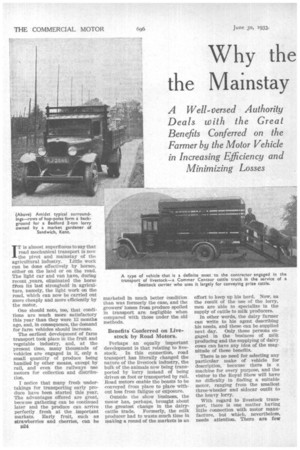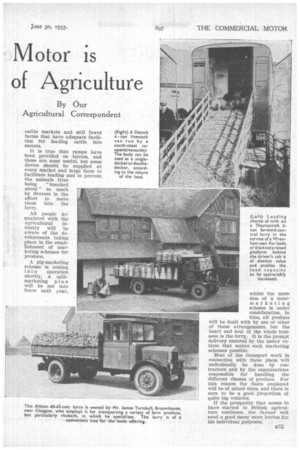Why the Motor is the Mainstay of Agriculture
Page 74

Page 75

If you've noticed an error in this article please click here to report it so we can fix it.
By Our Agricultural Correspondent
A Well-versed Authority Deals with the Great Benefits Conferred on the Farmer by the Motor Vehicle in Increasing Efficiency and Minimizing Losses
IT is almost superfluous to say that road mechanical transport is now the pivot and mainstay of the agricultural industry. Little work can be done effectively by horses, either on the land or on the road. The light car and van have, during recent ,years, eliminated the horse from its last stronghold in agriculture, namely, the light work on the road, which can now be carried out more cheaply and more efficiently by the motor.
One should note, too, that conditions are much more satisfactory this year than they were 12 months ago, and, in consequence, the demand for farm vehicles should increase.
The earliest development of farm transport took place in the fruit and vegetable industry, and, at the present time, many thousands of vehicles are engaged in if, only a small quantity of produce being handled by other means, except by rail, and even the railways use motors for collection and distribution.
I notice that many fresh undertakings for transporting early produce have been started this year. The advantages offered are great, because gathering can be continued later and the produce can arrive perfectly fresh at the important markets. Early fruit, such as strawberries and cherries, can be
1)24 marketed in much better condition than was formerly the case, and the growers' losses from produce spoiled in transport are negligible when compared with those under the old methods.
Benefits Conferred on Livestock by Road Motors.
Perhaps an equally important development is that relating to livestock. In this connection, road transport has literally changed the nature of the livestock industry, the bulk of the animals now being transported by lorry instead of being driven on foot or transported by rail.
• Road motors enable the beasts to be conveyed from place to place without loss from fatigue or exposure.
Outside the show business, the motor has, perhaps, brought about the greatest change in the dairycattle trade. Formerly, the milk producer had to waste much time in making a round of the markets in an effort to keep up his herd. Now, as the result of the use of the lorry, men are able to specialize in the supply of cattle to milk producers.
In other words, the dairy farmer can write to his agent describing his needs, and these can be supplied next day. Only those persons engaged in the business of milk producing and the supplying of dairy cows can have any idea of the magnitude of these benefits.
There is no need for selecting any particular make of vehicle for description, because there is a machine for every purpose, and the visitor to the Royal Show will have no difficulty in finding a suitable motor, ranging from the smallest three-wheeler and sidecar outfit to the heavy lorry.
With regard to livestock transport, there is one matter having little connection with motor manufacture, but which, nevertheless, needs attention. There are few
cattle markets and still fewer farms that have adequate facilities for loading cattle into motors.
It is true that ramps have been provided on lorries, and these are most useful, but some device should be supplied at every market and large farm to facilitate loading and to prevent the animals from being "knocked about" so much by drovers in the effort to move them into the lorry.
All people acquainted with the agricultural industry will be aware of the developments taking place in the establishment of marketing schemes for produce.
A pig-marketing scheme is coming I nto operation shortly, a milkmarketing plan Will be put into force next year, whilst the question of a meatmarketing scheme is under consideration. In time, all produce will be dealt with by one or other of these arrangements, but the heart and soul of the whole business is the lorry. It is the prompt delivery ensured by the motor vehicle that makes such marketing schemes possible.
Most of the transport work in connection with these plans will undoubtedly be done by contractors and by the organizations responsible for handling the different classes of produce. For this reason the fleets employed will be of mixed sizes, and there is sure to be a good proportion of quite big vehicles.
If the prosperity that seems to have started in British agriculture continues, the farmer will need a good many more lorries fe
his individual purposes. ,




















































































































































